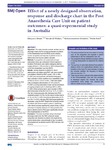Effect of a newly designed observation, response and discharge chart in the Post Anaesthesia Care Unit on patient outcomes: a quasi-experimental study in Australia
| dc.contributor.author | Kent, B | |
| dc.contributor.author | Street, M | |
| dc.contributor.author | Phillips, NM | |
| dc.contributor.author | Mohebbi, M | |
| dc.date.accessioned | 2018-01-12T12:53:21Z | |
| dc.date.available | 2018-01-12T12:53:21Z | |
| dc.date.issued | 2017-12-03 | |
| dc.identifier.issn | 2044-6055 | |
| dc.identifier.issn | 2044-6055 | |
| dc.identifier.other | ARTN e015149 | |
| dc.identifier.uri | http://hdl.handle.net/10026.1/10565 | |
| dc.description.abstract |
<jats:sec><jats:title>Objectives</jats:title><jats:p>This study aimed to evaluate whether use of a discharge criteria tool for nursing assessment of patients in Post Anaesthesia Care Unit (PACU) would enhance nurses’ recognition and response to patients at-risk of deterioration and improve patient outcomes.</jats:p></jats:sec><jats:sec><jats:title>Methods</jats:title><jats:p>A prospective non-randomised pre–post intervention study was conducted in three hospitals in Australia. Participants were adults undergoing elective surgery before (n=723) and after (n=694) implementation of the Post-Anaesthetic Care Tool (PACT).</jats:p></jats:sec><jats:sec><jats:title>Results</jats:title><jats:p>Nursing response to patients at-risk of deterioration was higher using PACT, with more medical consultations initiated by PACU nurses (19% vs 30%, P<0.001) and more patients with Medical Emergency Team activation criteria modified by an anaesthetist while in PACU (6.5% vs 13.8%, P<0.001). There were higher rates of analgesia administration (37.3% vs 54.2%, P=0.001), nursing assessment of pain and documentation of ongoing analgesia prior to discharge (55% vs 85%, P<0.001). More adverse events were recorded in PACU after introduction of the PACT (8.3% vs 16.7%, P<0.001). The rate of adverse events after discharge from PACU remained constant (16.5%), but the rate of cardiac events (5.1% vs 2.6%, P=0.021) and clinical deterioration (8.7% vs 4.3%, P=0.001) following PACU discharge significantly decreased, using the PACT. Despite the increased number of patients with adverse events in phase 2, healthcare costs did not increase significantly. Length of stay in PACU and length of hospital admission for those patients who had an adverse event in PACU were significantly reduced after implementation of the PACT.</jats:p></jats:sec><jats:sec><jats:title>Conclusion</jats:title><jats:p>This study found that using a structured discharge criteria tool, the PACT, enhanced nurses’ recognition and response to patients who experienced clinical deterioration, reduced length of stay for patients who experienced an adverse event in PACU and was cost-effective.</jats:p></jats:sec> | |
| dc.format.extent | e015149-e015149 | |
| dc.format.medium | Electronic | |
| dc.language | en | |
| dc.language.iso | en | |
| dc.publisher | BMJ Publishing Group | |
| dc.subject | health Economics | |
| dc.subject | surgery | |
| dc.subject | Adult | |
| dc.subject | Anesthesia Recovery Period | |
| dc.subject | Australia | |
| dc.subject | Elective Surgical Procedures | |
| dc.subject | Female | |
| dc.subject | Humans | |
| dc.subject | Length of Stay | |
| dc.subject | Male | |
| dc.subject | Middle Aged | |
| dc.subject | Nursing Assessment | |
| dc.subject | Outcome Assessment, Health Care | |
| dc.subject | Patient Discharge | |
| dc.subject | Postoperative Care | |
| dc.subject | Postoperative Complications | |
| dc.subject | Practice Patterns, Nurses' | |
| dc.subject | Prospective Studies | |
| dc.title | Effect of a newly designed observation, response and discharge chart in the Post Anaesthesia Care Unit on patient outcomes: a quasi-experimental study in Australia | |
| dc.type | journal-article | |
| dc.type | Journal Article | |
| plymouth.author-url | https://www.webofscience.com/api/gateway?GWVersion=2&SrcApp=PARTNER_APP&SrcAuth=LinksAMR&KeyUT=WOS:000423826700010&DestLinkType=FullRecord&DestApp=ALL_WOS&UsrCustomerID=11bb513d99f797142bcfeffcc58ea008 | |
| plymouth.issue | 12 | |
| plymouth.volume | 7 | |
| plymouth.publication-status | Published | |
| plymouth.journal | BMJ Open | |
| dc.identifier.doi | 10.1136/bmjopen-2016-015149 | |
| plymouth.organisational-group | /Plymouth | |
| plymouth.organisational-group | /Plymouth/Faculty of Health | |
| plymouth.organisational-group | /Plymouth/Faculty of Health/School of Nursing and Midwifery | |
| plymouth.organisational-group | /Plymouth/REF 2021 Researchers by UoA | |
| plymouth.organisational-group | /Plymouth/REF 2021 Researchers by UoA/UoA03 Allied Health Professions, Dentistry, Nursing and Pharmacy | |
| plymouth.organisational-group | /Plymouth/Research Groups | |
| plymouth.organisational-group | /Plymouth/Research Groups/Institute of Health and Community | |
| plymouth.organisational-group | /Plymouth/Research Groups/Plymouth Institute of Health and Care Research (PIHR) | |
| plymouth.organisational-group | /Plymouth/Users by role | |
| plymouth.organisational-group | /Plymouth/Users by role/Academics | |
| dc.publisher.place | England | |
| dcterms.dateAccepted | 2017-10-23 | |
| dc.identifier.eissn | 2044-6055 | |
| dc.rights.embargoperiod | Not known | |
| rioxxterms.versionofrecord | 10.1136/bmjopen-2016-015149 | |
| rioxxterms.licenseref.uri | http://www.rioxx.net/licenses/all-rights-reserved | |
| rioxxterms.licenseref.startdate | 2017-12-03 | |
| rioxxterms.type | Journal Article/Review |


